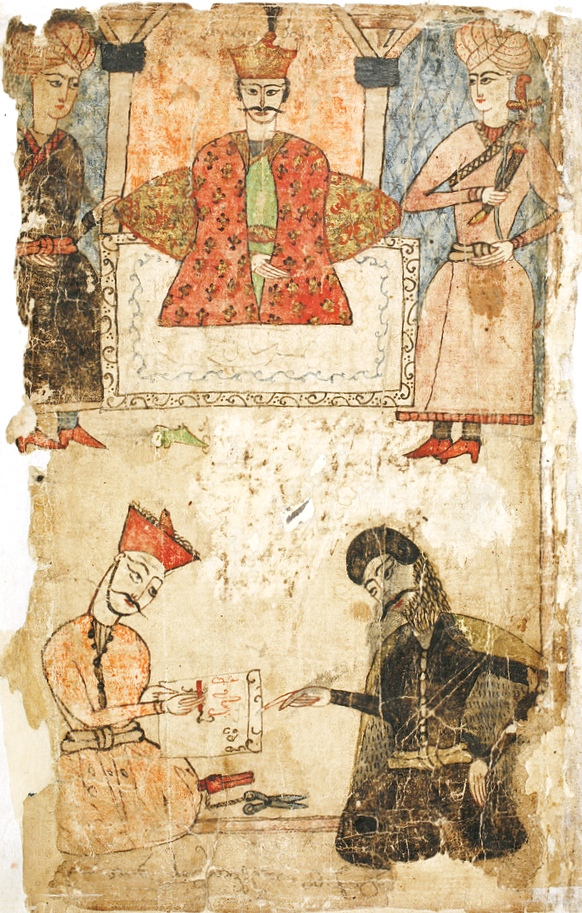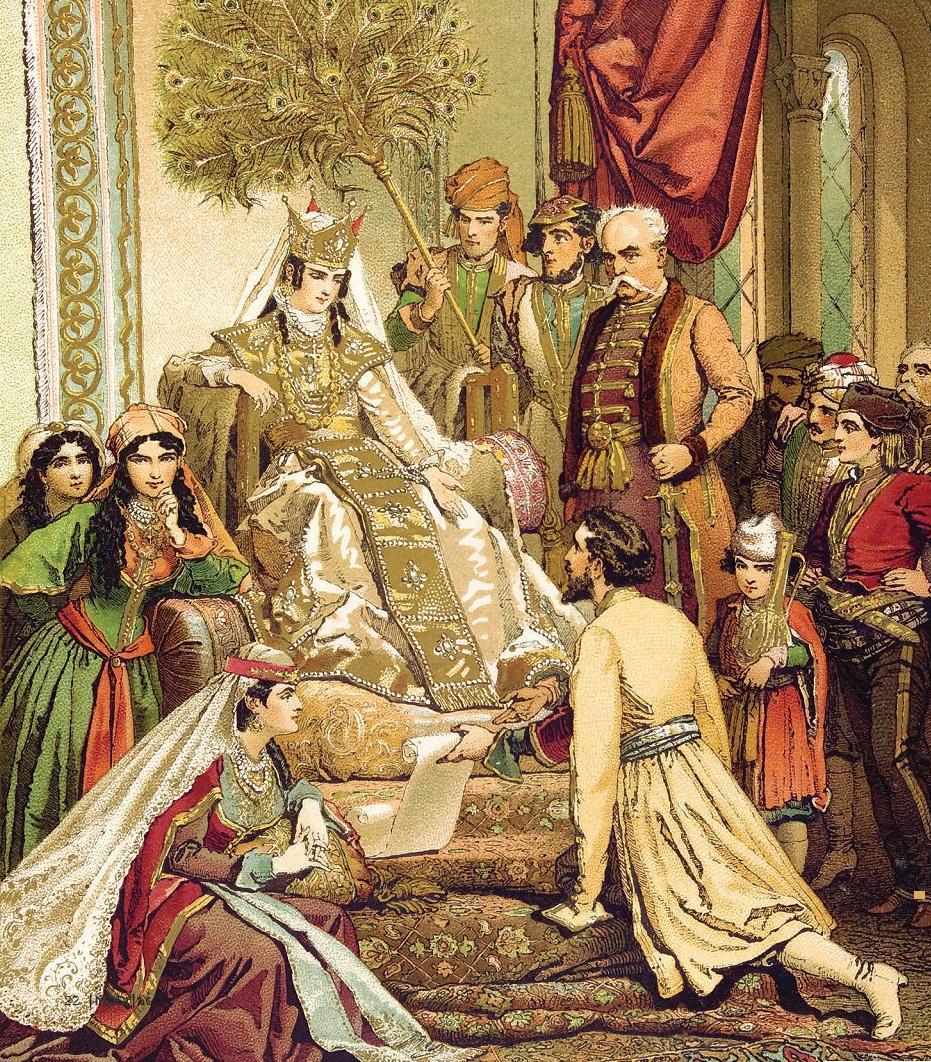|
Mamuka Tavakalashvili
Mamuka Tavakalashvili or Tavakarashvili ( ka, ·Éõ·Éê·Éõ·É£·Éô·Éê ·Éó·Éê·Éï·Éê·É•·Éê·Éö·Éê·É®·Éï·Éò·Éö·Éò) was a Georgian poet, painter and famous calligrapher of the 17th century at the court of the King of Imereti. He was captured in Principality of Samegrelo in 1634 during the Georgian feudal fights when kings Teimuraz I of Kakheti and George III of Imereti waged war against King Rostom of Kartli and the Dadiani princes of Samegrelo. After this Mamuka worked as calligrapher at the court of Prince Levan II Dadiani. In 1646 he copied The Knight in the Panther's Skin where he created 39 miniatures. In 1647 Tavakalashvili also copied the Georgian translation of Shahnameh. References *Georgian Soviet Encyclopedia, ·É¢. 4, ·Éí·Éï. 562, ·Éó·Éë., 1979 *Korneli Kekelidze Korneli Kekelidze ( ka, ·Éô·Éù·ÉÝ·Éú·Éî·Éö·Éò ·Éô·Éî·Éô·Éî·Éö·Éò·É´·Éî) (April 30, 1879 ‚Äì June 7, 1962) was a Soviet and Georgian philologist, scholar of Georgian literature, and one of the founding fathers of the ... [...More Info...] [...Related Items...] OR: [Wikipedia] [Google] [Baidu] |
The Knight In The Panther's Skin
''The Knight in the Panther's Skin'' ( ka, ვეფხისტყაოსანი, tr literally "the one with the skin of a tiger") is a Georgian medieval epic poem, written in the 12th or 13th century by Georgia's national poet Shota Rustaveli. A definitive work of the Georgian Golden Age, the poem consists of over 1600 Rustavelian Quatrains and is considered to be a "masterpiece of the Georgian literature". Until the early 20th century, a copy of this poem was part of the dowry of every bride. Although the poem takes place in the fictional settings of "India" and "Arabia", events in these distant lands are but a colorful allegory of the rule of Queen Tamar of Georgia, and the size and glory of the Kingdom of Georgia in its Golden Age. It tells the friendship of two heroes, Avtandil and Tariel, and their quest to find the object of love, Nestan-Darejan, an allegorical embodiment of Queen Tamar. These idealized heroes and devoted friends are united by courtly love, generosi ... [...More Info...] [...Related Items...] OR: [Wikipedia] [Google] [Baidu] |
Manuscript Illuminators
A manuscript (abbreviated MS for singular and MSS for plural) was, traditionally, any document written by hand – or, once practical typewriters became available, typewritten – as opposed to mechanically printed or reproduced in some indirect or automated way. More recently, the term has come to be understood to further include ''any'' written, typed, or word-processed copy of an author's work, as distinguished from the rendition as a printed version of the same. Before the arrival of printing, all documents and books were manuscripts. Manuscripts are not defined by their contents, which may combine writing with mathematical calculations, maps, music notation, explanatory figures, or illustrations. Terminology The study of the writing in surviving manuscripts, the "hand", is termed palaeography (or paleography). The traditional abbreviations are MS for manuscript and MSS for manuscripts, while the forms MS., ms or ms. for singular, and MSS., mss or mss. for plu ... [...More Info...] [...Related Items...] OR: [Wikipedia] [Google] [Baidu] |
Painters From Georgia (country)
Painting is the practice of applying paint, pigment, color or other medium to a solid surface (called the "matrix" or "support"). The medium is commonly applied to the base with a brush, but other implements, such as knives, sponges, and airbrushes, can be used. In art, the term ''painting ''describes both the act and the result of the action (the final work is called "a painting"). The support for paintings includes such surfaces as walls, paper, canvas, wood, glass, lacquer, pottery, leaf, copper and concrete, and the painting may incorporate multiple other materials, including sand, clay, paper, plaster, gold leaf, and even whole objects. Painting is an important form in the visual arts, bringing in elements such as drawing, composition, gesture (as in gestural painting), narration (as in narrative art), and abstraction (as in abstract art). Paintings can be naturalistic and representational (as in still life and landscape painting), photographic, abstract, narrative, sy ... [...More Info...] [...Related Items...] OR: [Wikipedia] [Google] [Baidu] |
17th-century Poets From Georgia (country)
The 17th century lasted from January 1, 1601 ( MDCI), to December 31, 1700 ( MDCC). It falls into the early modern period of Europe and in that continent (whose impact on the world was increasing) was characterized by the Baroque cultural movement, the latter part of the Spanish Golden Age, the Dutch Golden Age, the French ''Grand Siècle'' dominated by Louis XIV, the Scientific Revolution, the world's first public company and megacorporation known as the Dutch East India Company, and according to some historians, the General Crisis. From the mid-17th century, European politics were increasingly dominated by the Kingdom of France of Louis XIV, where royal power was solidified domestically in the civil war of the Fronde. The semi-feudal territorial French nobility was weakened and subjugated to the power of an absolute monarchy through the reinvention of the Palace of Versailles from a hunting lodge to a gilded prison, in which a greatly expanded royal court could be more easily ke ... [...More Info...] [...Related Items...] OR: [Wikipedia] [Google] [Baidu] |
17th-century People From Georgia (country)
The 17th century lasted from January 1, 1601 ( MDCI), to December 31, 1700 ( MDCC). It falls into the early modern period of Europe and in that continent (whose impact on the world was increasing) was characterized by the Baroque cultural movement, the latter part of the Spanish Golden Age, the Dutch Golden Age, the French ''Grand Siècle'' dominated by Louis XIV, the Scientific Revolution, the world's first public company and megacorporation known as the Dutch East India Company, and according to some historians, the General Crisis. From the mid-17th century, European politics were increasingly dominated by the Kingdom of France of Louis XIV, where royal power was solidified domestically in the civil war of the Fronde. The semi-feudal territorial French nobility was weakened and subjugated to the power of an absolute monarchy through the reinvention of the Palace of Versailles from a hunting lodge to a gilded prison, in which a greatly expanded royal court could be more easily ke ... [...More Info...] [...Related Items...] OR: [Wikipedia] [Google] [Baidu] |
Calligraphers From Georgia (country)
Calligraphy (from el, link=y, καλλιγραφία) is a visual art related to writing. It is the design and execution of lettering with a pen, ink brush, or other writing instrument. Contemporary calligraphic practice can be defined as "the art of giving form to signs in an expressive, harmonious, and skillful manner". Modern calligraphy ranges from functional inscriptions and designs to fine-art pieces where the letters may or may not be readable. Classical calligraphy differs from type design and non-classical hand-lettering, though a calligrapher may practice both. CD-ROM Calligraphy continues to flourish in the forms of wedding invitations and event invitations, font design and typography, original hand-lettered logo design, religious art, announcements, graphic design and commissioned calligraphic art, cut stone inscriptions, and memorial documents. It is also used for props and moving images for film and television, and also for testimonials, birth and death certifi ... [...More Info...] [...Related Items...] OR: [Wikipedia] [Google] [Baidu] |
Korneli Kekelidze
Korneli Kekelidze ( ka, ·Éô·Éù·ÉÝ·Éú·Éî·Éö·Éò ·Éô·Éî·Éô·Éî·Éö·Éò·É´·Éî) (April 30, 1879 ‚Äì June 7, 1962) was a Soviet and Georgian philologist, scholar of Georgian literature, and one of the founding fathers of the Tbilisi State University where he chaired the Department of the History of Old Georgian Literature from 1918 until his death. Kekelidze left a diverse literary and scholarly legacy that laid foundation for critical study of the Georgian literature. He discovered, studied and published several pieces of Old Georgian literature. His most influential work ''A History of Old Georgian Literature'' (·É´·Éï·Éî·Éö·Éò ·É•·Éê·ÉÝ·Éó·É£·Éö·Éò ·Éö·Éò·É¢·Éî·ÉÝ·Éê·É¢·É£·ÉÝ·Éò·É° ·Éò·É°·É¢·Éù·ÉÝ·Éò·Éê) went through four editions between 1923 and 1960. The magnitude of Kekelidze‚Äôs accomplishments was recognized by the naming of the Georgian Institute of Manuscripts in Tbilisi in his honor. Kekelidze became a member of the Georgian National Academy of Sciences The Georgian Nation ... [...More Info...] [...Related Items...] OR: [Wikipedia] [Google] [Baidu] |
Georgian Soviet Encyclopedia
The ''Georgian Soviet Encyclopedia'' ( ka, ·É•·Éê·ÉÝ·Éó·É£·Éö·Éò ·É°·Éê·Éë·É≠·Éù·Éó·Éê ·Éî·Éú·É™·Éò·Éô·Éö·Éù·Éû·Éî·Éì·Éò·Éê, ·É•·É°·Éî) is the first universal encyclopedia in the Georgian language, printed in Tbilisi from 1965, the editor in chief of which was Irakli Abashidze. The encyclopedia consists of 11 alphabetic volumes and a 12th exclusively dedicated to the Georgian SSR, printed in both Georgian and Russian. Sources * R. Metreveli, ''Georgian Soviet Encyclopedia'', X, p. 483, Tbilisi, 1986 See also * ''Great Soviet Encyclopedia The ''Great Soviet Encyclopedia'' (GSE; ) is one of the largest Russian-language encyclopedias, published in the Soviet Union from 1926 to 1990. After 2002, the encyclopedia's data was partially included into the later ''Bolshaya rossiyskaya e ...'' National Soviet encyclopedias Georgian Soviet Socialist Republic Georgian-language encyclopedias 20th-century encyclopedias {{Encyclopedia-stub ... [...More Info...] [...Related Items...] OR: [Wikipedia] [Google] [Baidu] |
Shahnameh
The ''Shahnameh'' or ''Shahnama'' ( fa, ÿ¥ÿߟáŸÜÿߟ֟á, ≈݃ÅhnƒÅme, lit=The Book of Kings, ) is a long epic poem written by the Persian poet Ferdowsi between c. 977 and 1010 CE and is the national epic of Greater Iran. Consisting of some 50,000 "distichs" or couplets (two-line verses), the ''Shahnameh'' is one of the world's longest epic poems. It tells mainly the mythical and to some extent the historical past of the Persian Empire from the creation of the world until the Muslim conquest in the seventh century. Iran, Azerbaijan, Afghanistan, Tajikistan and the greater region influenced by Persian culture such as Armenia, Dagestan, Georgia, Turkey, Turkmenistan and Uzbekistan celebrate this national epic. The work is of central importance in Persian culture and Persian language, regarded as a literary masterpiece, and definitive of the ethno-national cultural identity of Iran. It is also important to the contemporary adherents of Zoroastrianism, in that it traces the historical ... [...More Info...] [...Related Items...] OR: [Wikipedia] [Google] [Baidu] |
Levan II Dadiani
Levan II Dadiani (also Leon; ka, ·Éö·Éî·Éï·Éê·Éú Éö·Éî·Éù·ÉúII ·Éì·Éê·Éì·Éò·Éê·Éú·Éò; 1597-1657) was a member of the House of Dadiani and ruler of the Principality of Mingrelia in western Georgia. Levan grew up in Kakheti under his grandfather King Alexander II, but at the age of fourteen became prince of Mingrelia when his father Manuchar I died in a hunting accident. In the 1620s, Levan engaged in armed conflict alongside Abkhazia and Gurieli against King Giorgi III of Imeretia. He subsequently accused his Abkhazian first wife of adultery, cut off her ears and nose and cast her from Mingrelia. He then invaded and looted Abkhazia, poisoned his two sons, abducted and married the wife of his uncle. He then repeatedly raided Imeretia, confiscating livestock and taking hostages for ransom. In 1646 he destroyed the walls of Kutaisi Kutaisi (, ka, ·É•·É£·Éó·Éê·Éò·É°·Éò ) is one of the oldest continuously inhabited cities in the world and the third-most populous city in Geor ... [...More Info...] [...Related Items...] OR: [Wikipedia] [Google] [Baidu] |
Georgians
The Georgians, or Kartvelians (; ka, ·É•·Éê·ÉÝ·Éó·Éï·Éî·Éö·Éî·Éë·Éò, tr, ), are a nation and indigenous Caucasian ethnic group native to Georgia and the South Caucasus. Georgian diaspora communities are also present throughout Russia, Turkey, Greece, Iran, Ukraine, United States, and European Union. Georgians arose from Colchian and Iberian civilizations of classical antiquity; Colchis was interconnected with the Hellenic world, whereas Iberia was influenced by the Achaemenid Empire until Alexander the Great conquered it. In the 4th century, the Georgians became one of the first to embrace Christianity and now the majority of Georgians are Orthodox Christians, with most following their national autocephalous Georgian Orthodox Church, although there are small Georgian Catholic and Muslim communities as well as a significant number of irreligious Georgians. Located in the Caucasus, on the continental crossroads of Europe and Asia, the High Middle Ages saw Georgian people form ... [...More Info...] [...Related Items...] OR: [Wikipedia] [Google] [Baidu] |









.jpg)